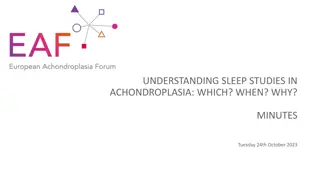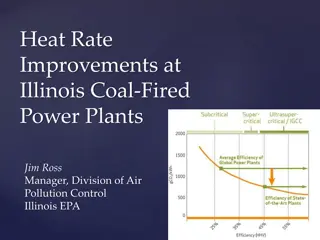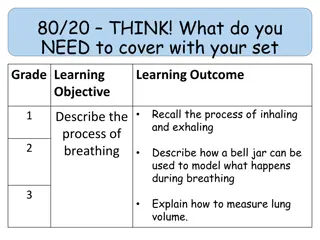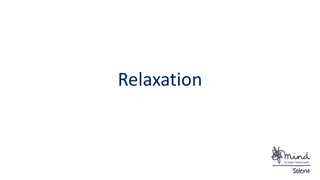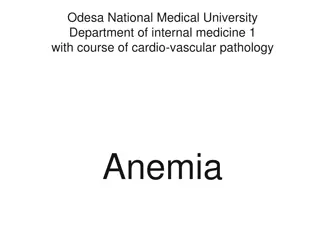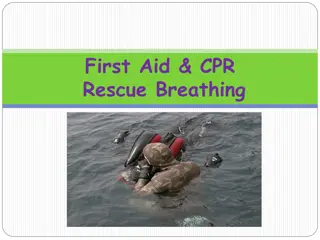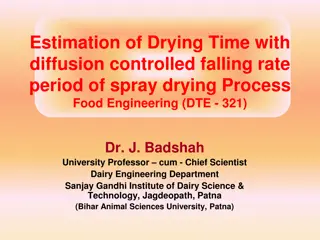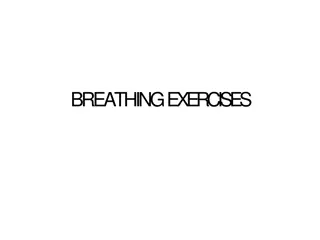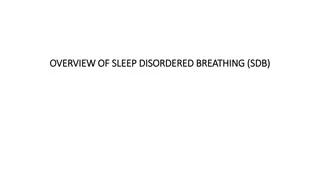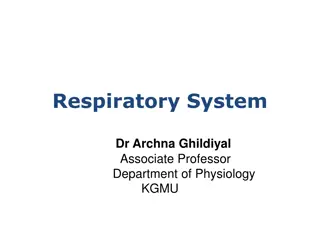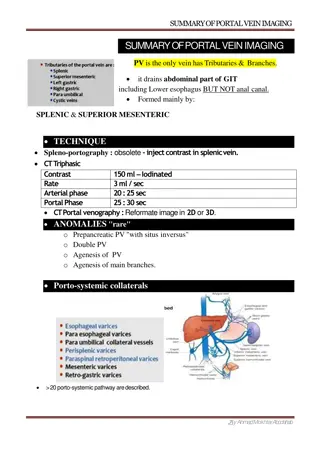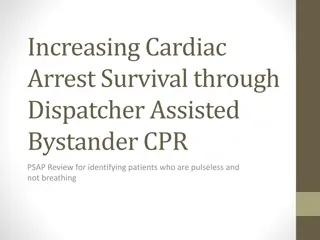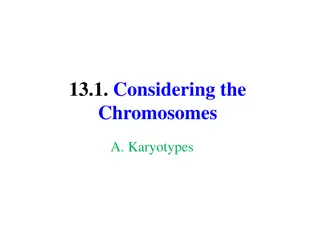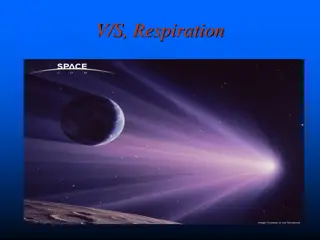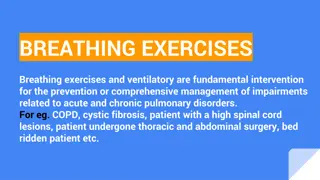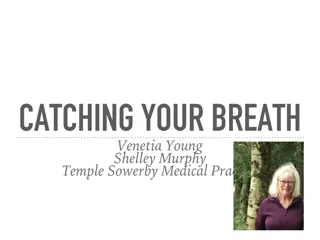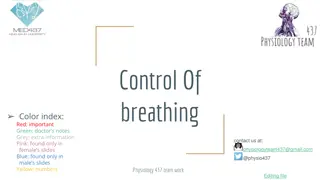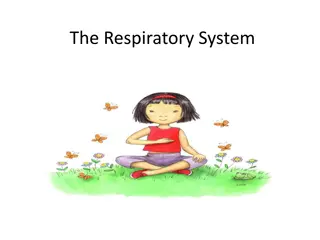Abnormalities in Rate, Depth, and Ease of Breathing
Abnormal breathing patterns like polypnea, hyperpnea, dyspnea, expiratory dyspnea, and inspiratory dyspnea can indicate various underlying conditions affecting respiratory and cardiovascular systems. Diseases causing dyspnea may stem from respiratory tract issues, cardiovascular diseases, or blood disorders, leading to labored breathing and reduced exercise tolerance.
Download Presentation

Please find below an Image/Link to download the presentation.
The content on the website is provided AS IS for your information and personal use only. It may not be sold, licensed, or shared on other websites without obtaining consent from the author.If you encounter any issues during the download, it is possible that the publisher has removed the file from their server.
You are allowed to download the files provided on this website for personal or commercial use, subject to the condition that they are used lawfully. All files are the property of their respective owners.
The content on the website is provided AS IS for your information and personal use only. It may not be sold, licensed, or shared on other websites without obtaining consent from the author.
E N D
Presentation Transcript
ABNORMALITIES IN RATE, DEPTH, AND EASE OF BREATHING By Dr. Hussein AlNaji
2 ABNORMALITIES IN RATE, DEPTH,AND EASE OF BREATHING a. Polypnea is a rate of breathing that is faster than observed in clinically normal animals of the same species, breed, age, sex, and reproductive status in a similar environment. b. Hyperpnea is an abnormal increase in the rate and depth of breathing (an abnormally high minute volume), but the breathing is not labored and is not associated with signs from which one could infer represent distress on the part of the animal (i.e., the animal is not dyspneic).
3 c- Dyspnea is a term borrowed from human medicine, in which it refers to the sensation of shortness of breath or air hunger. It is used in veterinary medicine to describe labored or difficult breathing in animals that also display some signs of distress, such as anxious expression, unusual posture or stance, or unusual behavior. d- Expiratory dyspnea is prolonged and forceful expiration, usually associated with Principal Manifestations of Respiratory Insufficiency diffuse or advanced obstructive lower airway disease. e- Inspiratory dyspnea is prolonged and forceful inspiration as a result of obstruction of the extrathoracic airways, such as with laryngeal obstruction or collapse of the cervical trachea.
DISEASES CAUSING DYSPNEA AT REST OR LACK OF EXERCISE TOLERANCE Dyspnea, along with hypoxemia and hypercapnia, are the clinical and laboratory findings. a. Respiratory Tract Disease Respiratory tract diseases interfere with normal gas transfere include 1. Flooding of alveoli with inflammatory cells and/or proteinrich fluid pneumonia and pulmonary edema. 2. Atelectasis (collapsed alveoli and small airways) pleural effusion, hemothorax, hydrothorax, pneumothorax, chylothorax, pyothorax, prolonged recumbency of large animals, and diaphragmatic hernia 3. Airway obstruction nasal obstruction, pharyngeal/laryngeal obstruction, tracheal/bronchial
5 b- Cardiovascular Disease It is causes inadequate perfusion of tissues including the lungs. There is reduced oxygen delivery to tissues, even in the presence of normal arterial oxygenation. 1- Cardiac disease. Cardiac dyspnea results from heart failure and is multifactorial. 2- Peripheral circulatory failure usually as a result of hypovolemic shock, although shock associated with toxemia, including endotoxemia, can cause dyspnea.
6 C- Diseases of the Blood Diseases of the blood cause inadequate delivery of oxygen to tissues because of anemia or presence of hemoglobin that is unable to carry oxygen. 1- Anemia an abnormally low concentration of hemoglobin 2- Altered hemoglobin methemoglobinemia (e.g., in nitrite poisoning of cattle, red maple toxicosis of horses), Carboxyhemoglobinemia.
d- Nervous System Diseases 7 Diseases of the nervous system affect respiratory function by one of several mechanisms: 1- Paralysis of respiratory muscles 2- Paralysis of the respiratory center. 3- Stimulation of the respiratory center. e- Musculoskeletal Diseases f- General Systemic States 1- Pain such as in horses with colic 2- Hyperthermia. 3- Acidosis. 1- Muscle disease. 2- Fatigue 3- Trauma
8 Principles of Treatment and Control of Respiratory Tract Disease the common principles are as follows 1- Ensure adequate oxygenation of blood and excretion of carbon dioxide. 2- Relieve pulmonary inflammation. include glucocorticoids and nonsteroidal antiinflammatory drugs (NSAIDs). 3- Effectively treat infectious causes of respiratory disease. 4- Relieve bronchoconstriction. 5- Provide supportive care to minimize demands for respiratory gas transport.
Diseases of the Upper Respiratory Tract RHINITIS Rhinitis (inflammation of the nasal mucosa) is characterized clinically by sneezing, wheezing, and stertor during inspiration and a nasal discharge that can be serous, mucoid, or purulent in consistency depending on the cause. Etiology Cattle 1- Catarrhal rhinitis in infectious bovine rhinotracheitis; adenoviruses 1, 2, and 3; and respiratory syncytial virus infections 2- Ulcerative/erosive rhinitis in bovine malignant catarrh, mucosal disease, rinderpest. 3- Actinobacillus lignieresii 4- Nasal schistosomiasis 5- Nasal mycosis 6- Nasal actinomycosis 9
Horses 10 1. Glanders, strangles, and epizootic lymphangitis. 2. Infections with the viruses of equine viral rhinopneumonitis (herpesvirus-1), equine herpesvirus-3,4 equine viral arteritis, influenza H3N8 equine rhinovirus, parainfluenza virus, reovirus, adenovirus 3. Chronic rhinitis claimed to be caused by dust in dusty stables, and acute rhinitis occurring after inhalation of smoke and fumes. 4. Nasal granulomas as a result of chronic infections with Pseudoallescheria boydii and Aspergillus, Conidiobolus, and Mucoraceous fungi. 5. Equine grass sickness (dysautonomia) .
Sheep and Goats 11 1. Melioidosis, bluetongue; rarely, contagious ecthyma and sheep pox 2. Oestrus ovis and Elaeophora schneideri infestations. 3. Allergic rhinitis. 4. Purulent rhinitis and otitis associated with P. aeruginosa in sheep.
CLINICAL FINDINGS 12 1. The primary clinical finding in rhinitis is a nasal discharge, which is usually serous initially but soon becomes mucoid and, in bacterial infections, purulent. Erythema, erosion, or ulceration may be visible on inspection. 2. The inflammation may be unilateral or bilateral. 3. Sneezing is characteristic in the early acute stages, and this is followed in the later stages by snorting and the expulsion of large amounts of mucopurulent discharge. 4. A chronic unilateral purulent nasal discharge lasting several weeks.
SummerSnuffles 13 Summersnuffles of cattle presents a characteristic syndrome involving several animals in a herd. Cases occur in the spring and autumn when the pasture is in flower and warm, moist environmental conditions prevail. 1. There is a sudden onset of dyspnea with a profuse nasal discharge of thick, orange to yellow material that varies from a mucopurulent to caseous consistency. 2. Sneezing, irritation, and obstruction are severe. 3. The irritation may cause the animal to shake its head, rub its nose along the ground, or poke its muzzle repeatedly into hedges and bushes.
14 4- Sticks and twigs may be pushed up into the nostrils as a result and cause laceration and bleeding. 5- Stertorous, difficult respiration accompanied by mouth breathing may be evident when both nostrils are obstructed. 6- In the chronic stages, multiple proliferative nonerosive nodules 2 to 8 mm in diameter and 4 mm high with marked mucosal edema are visible in the anterior nares.
Familial Allergic Rhinitis 15 In familial allergic rhinitis in cattle. 1. The clinical signs begin in the spring and last until late fall. 2. Affected animals exhibit episodes of violent sneezing and extreme pruritus manifested by rubbing their nostrils on the ground, trees etc. 3. Dyspnea and loud snoring sounds are common, and affected animals frequently clean their nostrils with their tongues. 4. The external nares contain a thick mucoid discharge, and the nasal mucosa is edematous and hyperemic.
EPISTAXIS AND HEMOPTYSIS 16 Epistaxis is bleeding from the nostrils regard less of the origin of the hemorrhage. Hemoptysis is the coughing up of blood, with the hemorrhage usually originating in the lungs. Both epistaxis and hemoptysis are important clinical signs in cattle and horses. Pulmonary hemorrhage as a cause of epistaxis or hemoptysis.
ETIOLOGY 17 1. Epistaxis occurs commonly in the horse and may be caused by lesions in the nasal cavity, nasopharynx, auditory tube diverticulum (guttural pouch), or lungs . 2. Epistaxis in horses can also be a result of trauma, progressive ethmoidal hematoma, foreign bodies lodged in the respiratory tract, hemorrhagic diatheses, sinusitis, nasal amyloidosis, polyps, and bleeding from the nasolacrimal duct. 3. Other less common causes of nasal bleeding include hemorrhagic polyps of the mucosa of the nasal cavity or paranasal sinuses, ethmoidal hematoma, Neoplasia, Poisoning
CLINICAL EXAMINATION 18 The nasal cavities should be examined visually with the aid of a strong, pointed source of light through the external nares. 1. In epistaxis resulting from systemic disease or clotting defects, the blood on the nasal mucosa will usually not be clotted. 2. When there has been recent traumatic injury to the nasal mucosa or erosion of a blood vessel by a space-occupying lesion such as tumor or nasal polyp, the blood will usually be found in clots in the external nares. 3. When the blood originates from a pharyngeal lesion there are frequent swallowing movements and a short explosive cough, which may be accompanied by the expulsion of blood from the mouth. 4. Radiologic examinations of the head are indicated when spaceoccupying lesions are suspected.
19 TREATMENT Specific treatment of epistaxis and hemoptysis depends on the cause. Hemorrhage from traumatic injuries to the nasal mucosa does not usually require any specific treatment. Space-occupying lesions of the nasal mucosa might warrant surgical therapy.
20 Thank You



